From March 1, more than 1800 different kinds of electronics in China need to have environmental protection stickers pasted somewhere in a visible location.
The rules for the use of these eco-friendly stickers comes from the recently promulgated "Requirement for Controlling the Pollution of Electronic Products", which is formally implemented on March 1, 2007.
All products now need to show the names of any poisonous elements in their construction, including content, use validity and recycling information. These products include mobile phones, laptops, computers, digital video cameras, MP3 players, MP4 devices, printers and a range of other electronics. Manufacturers, sellers, distributors and recyclers of electrical and electronic equipment containing lead, mercury, cadmium, hexavalent chromium, polybrominated biphenyls and polybrominated diphenyl ethers are most affected.
Those poisonous materials limited by this new requirement are similar as those covered by the Restriction of Hazardous Substances directive passed by the European Union in January 2003. Those RoHS regulations were made to protect human health and the environment by restricting the use of certain hazardous substances in new equipment and to complement the Waste Electrical and Electronic Equipment (WEEE) Directive (2002/96/EC).
Unlike EU RoHS, where products are included unless specifically excluded, in China there will be a list of included products, known as "the catalogue" which will be a subset of the total scope of Electronic Information Products, or EIPs, to which the regulations apply. There are some products that are EIPs, which are not in scope for EU RoHS such as radar systems, semiconductor manufacturing equipment, and photomasks.



